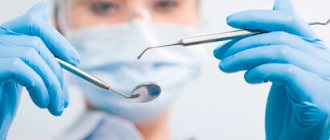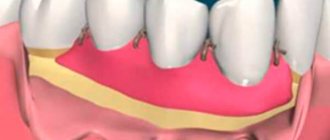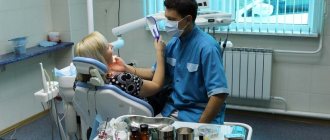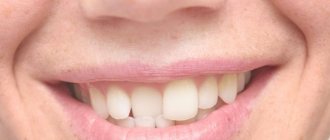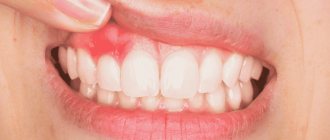When are teeth filled?
As a rule, a filling is placed after depulpation during diseases such as:
- caries;
- periodontitis;
- pulpitis.
The choice of filling installation method will directly depend on the specific case and is determined by the treating dentist. A professional specialist never installs a filling without first taking care to relieve inflammation after treatment. The filling is placed on a healthy tooth - if the treatment was not good enough, the disease will soon make itself felt again.
Installing a filling on a tooth: indications
It is recommended to put a filling in dentistry mainly for caries. This is a pathological process that consists of the slow, gradual destruction of tooth tissue under the influence of bacteria contained in soft plaque. As a result of their vital activity, these bacteria produce acids that destroy calcium in tooth enamel. The enamel becomes fragile and is destroyed, forming carious cavities, which, without proper treatment, gradually increase more and more.
By installing a filling on a tooth, you can restore a crown that has been destroyed by caries by about a third. If the tooth tissues are more damaged, then other methods of their restoration are used.
However, caries is not the only reason to get a filling in dentistry. Filling can also correct:
- cracks and chips of enamel;
- traumatic injuries;
- erased enamel (with bruxism).
Preparing for dental fillings
Preparation is carried out in several main stages, the purpose of which is to minimize the risk of foreign substances entering the tooth and reduce the patient’s pain from the procedure. The dentist is required to check each tooth canal for the presence of foreign contaminants, as well as the absence of inflammation or other disease that could cause it.
When preparing, the doctor adheres to a strict sequence of actions:
- Elimination of damaged and dead tissue.
- Depulpation.
- Acquaintance with the anatomy of dental canals, measuring their main parameters: length, width.
- Pre-treatment of the canals as preparation: this will expand them and be ready for filling.
- Sealing the canals with a special hermetic material.
All of the above actions are taken by the dentist exclusively while the patient is under local anesthesia.
Dental microscope for filling
This device is an irreplaceable thing in certain cases when:
|
A microscope and other optics allow the dentist to take a closer look at the problem in order to best solve it: often incorrect actions of your previous attending physician can negatively affect new procedures if you are not careful enough to notice the problem in time.
Quite often, upon close examination, it turns out that mistakes were made in installing the seal or its depressurization was detected - these are sure signs of incorrect treatment.
Symptoms for which people consult an orthopedic dentist
Consultation with a specialist is necessary if the following symptoms are present:
- absence of any number of teeth in a row (as a result of planned removal, loss, after injury, etc.);
- partial or almost complete destruction of the enamel and walls of the tooth;
- diagnosed diseases of the gums or jaw bones;
- increased (and in some cases painful) tooth sensitivity;
- various types of TMJ disease (temporomandibular joint);
- cosmetic defects (in particular, irregular shape, pigmentation and other disorders that spoil the aesthetics of the smile).
A dental therapist or other highly specialized specialist can diagnose problems that should be addressed specifically by an orthopedic dentist after an initial examination and consultation.
You might be interested in:
Pulpitis
Dental restoration
Treatment of caries
Dental treatment
Materials for filling
After examining the dental canals and carrying out all the necessary treatment procedures, the dentist will have to choose the right material for the future filling. They differ in their elasticity, purpose and properties. Some fillings can disinfect the area nearby, thereby preventing a new disease, while others can only correct the tooth, relieving the patient of discomfort and the entry of food particles into the root canal.
Among the most popular mixtures:
- Gutta-percha
- fills the canals well and is quite elastic, but has shrinkage; - AH-plus
- has an antimicrobial effect, wear-resistant; - Metapex
- has an antibacterial effect; - Akrosil
- often used with gutta-percha; - Forfenan
- is not used for front teeth, as it can stain them, but has a good antibacterial effect.
Today, dentists rarely use only one mixture when installing a filling: this approach is considered ineffective due to the individual characteristics of each solution.
How is the diagnosis performed at the initial appointment with an orthopedic dentist?
Modern dentistry allows almost all manipulations to be performed painlessly for the patient. At the same time, some people who have had bad experiences in the past are afraid of visiting clinics. Most often, they prefer to know in advance what a specialist will do in order to mentally prepare not only for the procedures, but also for the initial examination, during which the diagnosis is made. If you are planning to visit a prosthetist for the first time, be prepared for the following stages of interaction:
- Basic: Questioning to collect anamnesis
. Here the specialist asks questions that will help you individually choose a method for solving the problem. - Facial examination
. To study the size of the mouth gap, possible shortening of the lower part of the face and asymmetry, features of the setting of the lips and chin. The tone of the lip muscles is also determined by palpation. - Oral examination
. The bite, shape, size and condition of existing teeth are carefully examined. The condition of the mucous membrane, the individual nuances of the formation of the frenulum of the lips are also assessed, the shape and span of the tongue, the arch of the hard palate and the general development of the jaws are studied. - X-ray
. Radiography allows you to assess the condition of the supporting units, as well as identify the presence of impacted and other special elements that cannot be detected without photographs.
(may be needed for a deeper study and accurate diagnosis):
- functional chewing samples are taken;
Based on the results of the main and additional examination, the specialist makes a diagnosis and develops individual treatment tactics. Knowing who an orthopedic dentist is, in what cases you should contact him and what he will do when you arrive at your appointment, visiting dentistry will not be so scary. And since the initial examination is absolutely painless and without discomfort, it makes sense to at least sign up for a consultation in order to understand the condition of your teeth and whether it is possible to save those about which you have complaints.
How can you tell if the filling is installed properly?
To check the installed filling, an additional photograph must be taken, which should show how well the dentist’s work was done. The filling material is highlighted in white, so even a person who does not understand dentistry can understand the picture. Each dental canal should be evenly filled with mixture from start to finish, and there should be no blurring, obvious holes or voids, or foreign objects, which could be a broken instrument.
Carefully check the quality of the work performed, because this is the key to the health of your teeth!
Who is a dental surgeon and what diseases does he treat?
Dental surgery is a separate branch of medicine, the purpose of which is not removal, as many believe, but the preservation of teeth in the oral cavity. A dental surgeon not only pulls out teeth, but also performs operations to preserve them, diagnoses diseases of the oral cavity and more. Must have the skills of a therapist, orthopedist, and he is also both a pediatric dentist and a plastic surgeon. These essential skills will be continually used in practice.
What does a dental surgeon do?
The main task is to preserve teeth using all currently available methods. He does this using operational methods. Provides the following services:
- prepares the oral cavity for installation of implants;
- removes benign and malignant tumors inside the mouth;
- carries out restorative maxillofacial manipulations;
- eliminates inflammation in the periodontium;
- deals with complex molar removal;
- corrects defects of the tongue and gums.
Pros - versatility, the ability to perform both complex and simple operations, cons - it is difficult to find a really good surgeon.
How is it different from a dental therapist?
The main differences are the methods of influence. The dentist-therapist performs artistic restoration of dental units using fillings (seals dental canals and crowns). He does not perform complex operations and does not remove complex teeth, unlike a dental surgeon. The therapist may have absolutely no understanding of prosthetics or bite correction, but this does not mean that he is worse, he just has a different specialization. These specialists should always work closely together to provide the best possible care to the patient.
The main difference between a dental surgeon and a therapist is the degree of radicality of the effect on the tissue.
What services does it provide and what diseases does it treat?
The list of services includes the following operations:
- plastic;
- cystectomy;
- resection of the apex of the tooth root;
- extraction of retained and dystopic eights;
- curettage;
- removal of tooth fragments;
- patchwork operations on the gums.
Operations are selected depending on the situation:
- When a patient loses teeth, he needs prosthetics and turns to an implantologist. If there is no such specialist in the clinic, the procedure is performed by a surgeon.
- The site is prepared and a titanium rod is installed in the bone, on which the artificial tooth will be attached.
- If you need to remove an unerupted figure eight, you cut the gum (and sometimes the bone), and then saw and take out the tooth piece by piece, using an extractor and a drill.
- If a cyst forms inside the jaw at the roots of the tooth, a cystectomy and resection of the apex of the tooth root is performed. These operations involve removing the cyst and part of the tooth root.
- Due to extensive periodontal disease or congenital anomalies, the patient may have gum defects associated with their structure. Such defects are corrected by an adult or pediatric dentist-surgeon using plastic surgery. It also restores the proportions of the jaw, which may be disrupted due to injury or congenital defects.
- In the treatment of periodontitis, thinning gums, and destruction of the jaw bone, the dentist performs flap surgery. Such an intervention involves excision and application of small flaps to areas of the mucous membranes where there is not enough tissue.
- In case of localized inflammation in the gum, when the cheek swells and everything hurts greatly, if the inflammation is caused by incomplete eruption of the wisdom tooth, the gingival hood above the tooth crown is opened, due to which the inflammatory process stops.
- If you need to clean periodontal pockets, remove stone from under the gums, deliver antiseptic medications to a hard-to-reach area, or stop alveolitis, curettage is performed. This surgical operation avoids extensive excision of the gums. Cavities in the gums are cleaned out with a curette.
Is it possible to call a surgeon at home?
Such a service exists, but few people know about it, since previously it was only available to patients with disabilities (disabled, elderly, mentally ill). Nowadays, many private clinics offer the service of calling a dentist at home. Every person who does not have the opportunity to go to the dentist because of work or fear can use the convenient service of calling a doctor at home and the doctor on duty will come to him.
It should be borne in mind that at home he can only carry out simple procedures, for example, diagnostics, pain relief, gum incision or teeth cleaning.
Complex operations require the use of special equipment that cannot be made mobile.
Does it heal or just pull teeth?
A specialist in the field of dental surgery also treats many oral diseases:
- abscess and cysts;
- alveolitis;
- ankylosis and arthritis of the temporomandibular region;
- dislocations and injuries of the jaw;
- gingivitis;
- dental hyperesthesia;
- bite deformities;
- infectious endocarditis;
- osteomyelitis;
- periodontitis and periodontal disease;
- pericoronaritis and pulpitis;
- stomatitis;
- sepsis, phlegmon, gumboil.
How long does the appointment last?
Depends on the problem with the teeth and its neglect. The appointment can last from 15 minutes if it is an examination or simple procedures, and up to several hours if it is complex operations. The duration of most operations is 40-60 minutes.
What else is included in the job description
If the qualifications of a dental surgeon allow, he can treat pathologies not related to teeth:
- inflammation of the facial nerve;
- inflammation of the lower jaw joint;
- dysfunction of the salivary glands.
Also, the dental surgeon examines and diagnoses diseases that are not related to the mouth, but give symptoms in a given place, such as syphilis and tuberculosis.
Cosmetic surgeries
In addition to basic dental operations, she performs plastic surgery:
- correction of the contour of the gum edge (gingivoplasty);
- expansion of the oral cavity (vestibuloplasty);
- trimming the lingual frenulum (frenuloplasty);
- elimination of recession (decrease in height) of the gums.
These operations improve periodontal tissue, correct speech therapy disorders and malocclusion deformities, and simplify further prosthetics. Also, a dental surgeon can correct aesthetic defects in appearance, namely congenital deformities: cleft palate, lips, defects of the ears and jaw.
Children's dentistry
Almost all of the listed services and functions may be required not only by adults, but also by children. A pediatric dental surgeon must undergo additional training, since working with children differs in many ways from working with adults. Must be able to correctly calculate anesthesia (so that a large dose does not hurt or cause harm) and perform operations quickly while the minimum dose of anesthesia is in effect. At this time, you need to talk to the child, calm him down and distract him.
Why does a surgeon need a certificate?
Every dentist needs this document, as it confirms their qualifications and level of professionalism. He has the right to treat people. The certificate is a mandatory document along with a diploma to work in the medical field. It is also desirable to have a certificate indicating the qualification category. There are two types of certificates:
- for compliance with ISO-9000 standards (these are international standards);
- StAR (Dental Association of Russia).
By studying the certificates, the patient can choose the best doctor and clinic.
Consequences of poor quality filling
A poorly filled tooth can not only cause an acute reaction of the body, but also a new infection, often with subsequent complications.
What does a bad filling mean?
- inflammation;
- flux and fistula;
- loss of filling;
- change in tooth color;
- allergy to the filling material;
- cyst and granuloma;
- exit of material beyond the root tip.
If you feel acute discomfort after installing a filling, be sure to contact your dentist! Timely consultation with a professional can save you from unpleasant diseases, which are accompanied not only by continuous pain, but also by high costs for their treatment.
Who is a periodontist?
A periodontist is a highly qualified dentist with a higher medical education who specializes in the correction and prevention of pathologies of soft tissues that fix segments in the jaw bone. The concept of “periodontium” includes:
- mucous membranes that line the surface of the mouth;
- soft gum tissue surrounding the segments;
- periodontium is a thin layer of connective tissue between the alveolar process and the cementum of the tooth;
- dental cement - mineral tissue surrounding the root;
- alveolar process - a dental bed penetrated by capillaries and nerve endings.
Where can you go in Ivanteevka if you have gum disease?
If you need the help of a periodontist, you can contact the Sanident dental clinic, one of the best in Ivanteyevka, as confirmed by reviews from our satisfied patients. We employ only professionals with extensive experience who use modern treatment methods, the best equipment and reliable drugs. With us you can quickly and inexpensively restore health to your teeth and gums.
Complex dentistry "Sanident" is located at the following addresses:
- Ivanteevka, st. Novoselki, 4 (Ivanteevka railway station);
- Shchelkovo, st. Central, 80 (railway station Voronok).
When do you need to urgently visit a periodontist?
All of the above signs of pathologies are a good reason to make an appointment with a dentist. In these cases, self-medication is strictly prohibited, since treatment should be aimed at eliminating not the signs, but the causes of the disease. And only a professional specialist can identify them and prescribe effective therapy.
The main signs of the need for examination by a periodontist include:
- bleeding gums;
- the first signals of the onset of the inflammatory process;
- painful sensations in the gums;
- release of fluid when pressing on the gums;
- noticeable loosening of teeth;
- the appearance of periodontal pockets in the periodontal areas;
- peeling of soft tissues and their subsidence;
- exposure of the dental neck;
- putrid taste and bad breath that does not go away even after brushing or rinsing;
- suppuration;
- change in the angle of inclination of the teeth.
All of the above signs indicate dangerous changes that require immediate medical attention.
